Blue Water Blog: Adventure Africa: travelling on the Gambia River, Part II
Martin Finkbeiner
· 22.04.2019
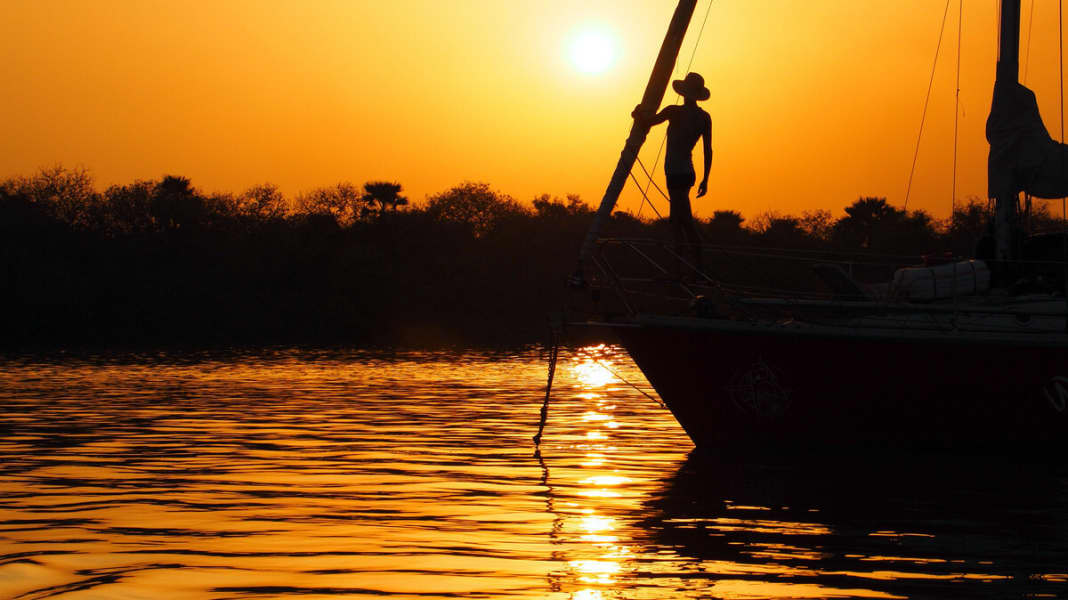
We have been travelling in The Gambia on the river of the same name for over two months now and haven't met another sailing boat in all that time. The trip to Africa is something very special for us. We live close to nature and get to know places that are rarely visited by other sailors or tourists. Although we are travelling in a country that is one of the poorest in the world, we haven't locked our boat for months.
The Gambia is a little paradise for cruising sailors with a thirst for adventure.
We chug 400 kilometres inland along the Gambia River, from Banjul on the coast to just before Basse far inland. The journey on the river is characterised by extremes: either we are anchored alone in the midst of the most beautiful nature and enjoy the peace and quiet, the flora and fauna around us. Or we are accompanied by huge crowds of children in the villages and towns along the river.
Aracanga" day care centre
Jareng Badala is located on a narrow branch of the Gambia River, which we enter at random. We have no water depths for the arm of the river and rely on the statement of a fisherman that it is deep enough. It is worth it. The village with its traditional palm-roofed mud houses is not only the most beautiful place so far, but also gives us an unforgettable welcome due to its remoteness.
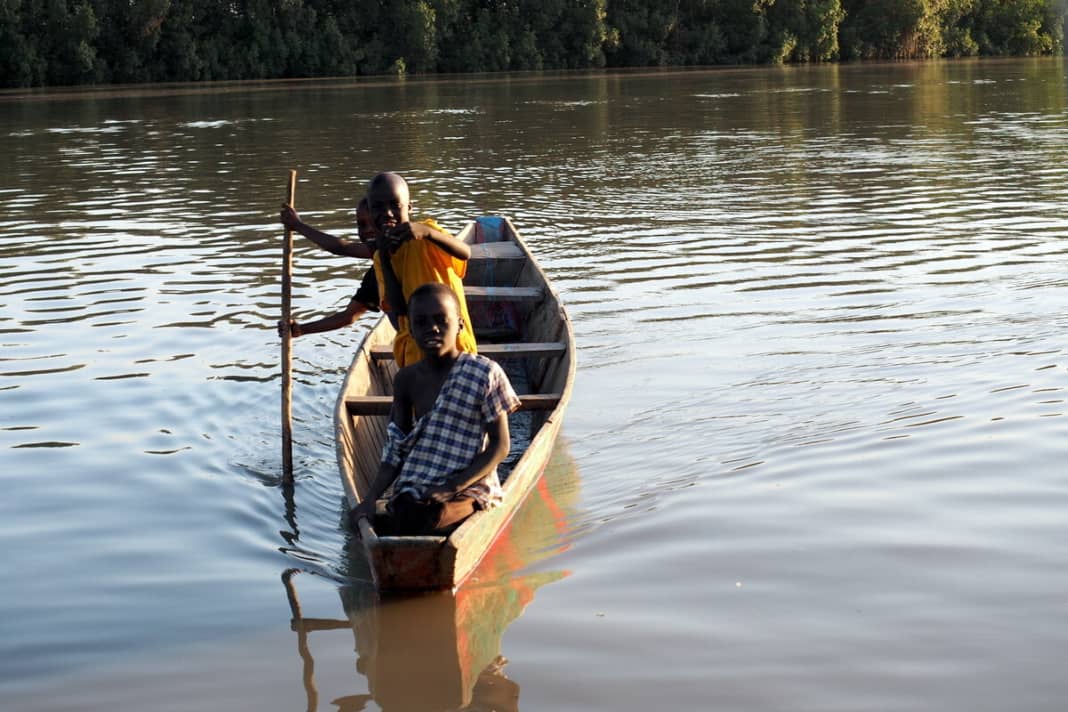





As soon as we land with our dinghy between the many fishermen's dug-out canoes, we are spotted by a crowd of children who shout loudly "toubab", as we are called here. They take us by the hand, one on each finger, and anyone who can't get another finger simply takes the next child by the hand, holds us by the T-shirt or simply puts their hand in our trouser pocket. From the landing site by the river, it is about 200 metres to the village, where we are accompanied by more and more laughing children who ask our names, wrestle for our fingers and sing local songs.
What we are asked for by all the children are empty plastic bottles in which they can fill drinking water. We have a few of these on board and we are happy about this kind of recycling.
The next day, the children don't wait for us to come ashore. They get into their canoes early in the morning and paddle out to us. Within a very short time, the entire cockpit is full of boys and girls who marvel at our boat with great interest and are delighted when we unpack and distribute our reserves of biscuits. And of course everyone wants to take a look below deck and see how we live. The foot pumps in the galley, with which we can pump water from the tank or from outboard into the sink, are a source of great amazement. But the highlight is the binoculars and radios. Everyone wants to call our buddy boat "Streuner" on the radio or have a chat between the handheld radio on deck and the radio in the cabin.
As exciting as it is for the children to see our home, the visits to the village are just as exciting for us.
We stay three days on the outward journey and another three days on the way back to the coast, and every day the boat is full of kids. No effort is too great for them to visit us, and so the smallest of them all paddles up alone in the biggest canoe, which he can barely move forwards against the current. His paddle is just a palm stalk, other children use their flip-flops or their hands to paddle.
Like so many other things, proper paddles are in short supply here, and we give away a lot of what we can do without. A few pocket knives, pens, books and footballs have changed hands in recent weeks. Apart from basic products, there is hardly anything to buy here. We still have a few last remaining treats on board, but you automatically adapt to local customs. We live relatively simply and eat what the locals eat, primarily rice with fish. We only make exceptions for our young visitors and bake cakes, which are initially eyed sceptically but then devoured with great appetite.
Monkeys and hippos
After the beautiful, but also exhausting visits to the villages along the river, we are usually in the mood for seclusion and nature, which can be found here in abundance. In addition to its long golden beaches, The Gambia is also known for its flora and fauna along the river. We get a real impression of impenetrable jungle, there is no getting through without a machete.
The further we travel inland along the river, the fewer mangroves we see on the banks, but all kinds of palm trees and mighty trees, mango, kapok, baobab, cashew and many more. It is a gallery forest, as is often found along large tropical rivers. Again and again we spot monkeys in the trees and countless different species of birds in all sizes and colours, from small turquoise kingfishers to mighty eagles, vultures, herons and pelicans.
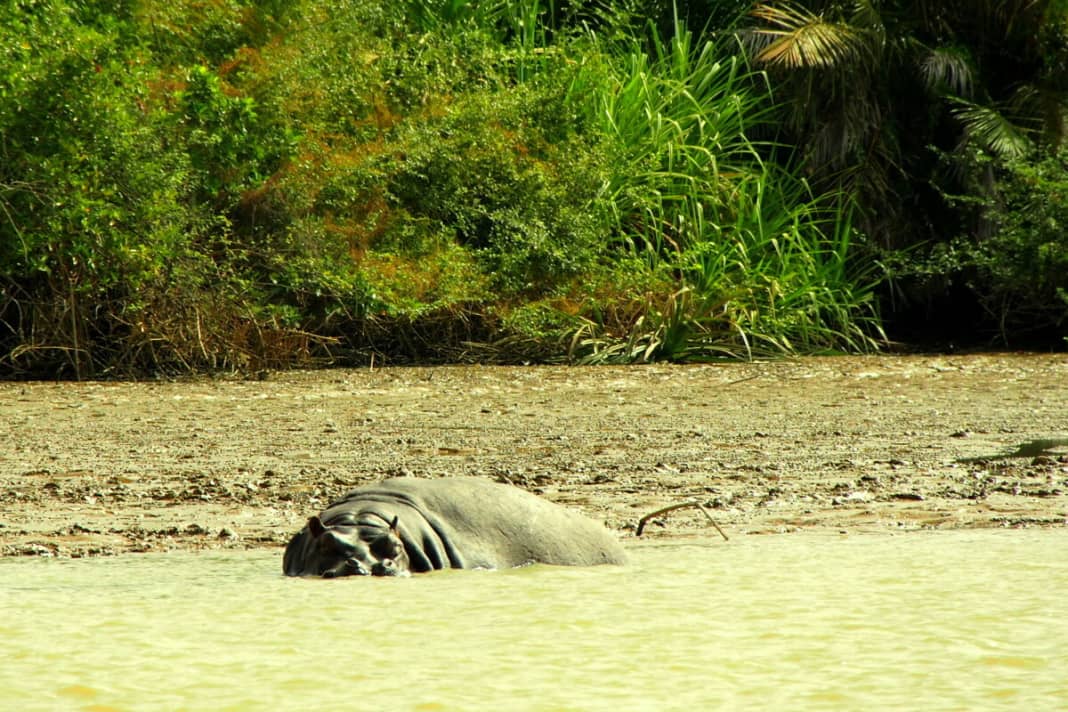





If you are interested in the Gambia River, you will stumble across the name Baboon Islands again and again. The group of islands in the river is a national park that is not open to the public. Chimpanzees that were illegally taken into captivity are released into the wild on the islands. Chimpanzees became extinct in The Gambia around a hundred years ago and attempts to reintroduce the animals here have been successful since the 1970s. However, the islands got their name Baboon Islands from the baboons that live here in large numbers.
The highlight for us, however, are completely different animals that we see here for the first time: Hippos. About a hundred metres from the "Aracanga", they leisurely make their rounds, dive down for a few minutes and then come up again, making impressive, barking and roaring noises.
They are beautiful to look at from a safe distance, but you shouldn't get too close to them. They are considered the most dangerous animals on the river. Even the children from the village warn us not to paddle too close: "They will kill you!" We sit mesmerised on deck with our binoculars and watch the monsters, which can become heavier than our boat.
The Cable
The further inland we go, the narrower and shallower the river becomes, with the depth sounder repeatedly showing a depth of just over three metres. And the further east we travel, the more unusual the sight of a sailing boat becomes. At Janjanboureg, a power line crosses the river, which is known throughout the country as "The Cable" and marks the turning point for most of the few sailing boats travelling the river. The power line supplies electricity to the island of MacCarthy (pronounced Makati) and the former capital of The Gambia, Janjanboureg. Large towns and cities are connected to the power grid, but the majority of villages and smaller towns have no electricity.
The power line across the river is a frequent topic of conversation for us, as nobody can tell us whether our boat will fit under it. The "Aracanga" is just over eleven metres high, and when we ask people, the answer is usually: "Yes, yes, no problem. But maybe you wait for low tide." The tidal difference here is just under one metre. In the end, there's only one thing left to do: try it out. We anchor for a night at MacCarthy, extend our visa, top up the water tanks and then give it a go.
The power line has high pylons on both banks and hangs far over the middle of the river. We travel close to the north bank, our friends from the "Streuner" follow us at a distance. This allows them to tell us from a distance whether they can see the power line above our mast stop or whether we need to turn off. It's impossible to estimate the height from your own boat.
We are suitably excited. But we are soon told on the radio: "No problem, you have at least three metres of clearance." Shortly afterwards, we are through and a new adventure begins. From now on, the charts are much less accurate, the depth information is often missing for several nautical miles, and rocks and shallows are marked in different places on different charts. The journey takes us along an increasingly barren landscape and the typical African red rocks.
Up here in the river, the water is much clearer, there are turtles and the rare manatees, one of which we get to see. We can also repeatedly observe crocodiles up to three and a half metres in size from the boat. At night, you can see the animals if you shine a powerful torch along the shore, the crocodiles' eyes reflect back yellow or red, and on an evening fishing trip with the dinghy, a large crocodile swims calmly about ten metres alongside our dinghy.
People are not normally attacked by the animals and they are afraid of the dinghy with outboard motor. Nevertheless, even in the extreme temperatures of 45 degrees and above, we are very careful about going into the water.
In addition to the many exciting and beautiful encounters with animals, there are also some real pests: tsetse flies and other mosquitoes. Fortunately, they are active during the day. We have peace and quiet at night, but we are still glad to have our mosquito screens over the companionway, hatch and bunk.
400 kilometres inland
We drop anchor off Diabugo Tenda, a small village more than 400 kilometres inland. The village consists of just two large families, although the majority of one family has relocated to Banjul. Our host Lamin shows us around, and in the village we meet an old man whom he introduces to us as his father. We talk to the man briefly and a little later we come across a group of men sitting in the shade of a mango tree. One of the men immediately stands up, greets me and also introduces himself as Lamin's father.
Father, brother, sister, uncle or aunt - such terms are not interpreted so narrowly here. Family does not mean mum, dad, child, but refers to an extended family of several generations. For the sake of simplicity, all children of the same age are referred to as "brother" or "sister". Lamin's extended family includes around 20 adults and at least 30 children.
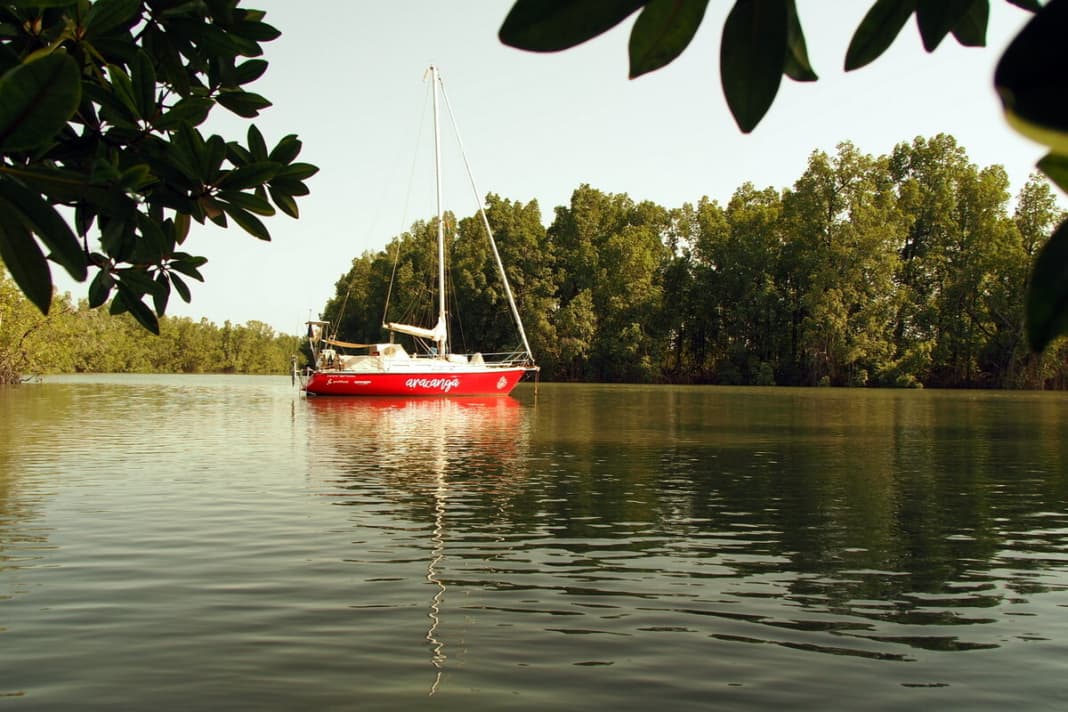





She runs the local ferry across the river and a small gold and silversmith's workshop. This consists of a fireplace with a bellows "concreted" into the clay floor, two anvils, two hammers and very few old tongs. It is primarily used to make the traditional jewellery of the "Fula", a cultural group that we often encounter along the river. However, there is a problem with the bellows, which is powered by an old bicycle rim and a V-belt made from knotted rubber scraps: the axle keeps jumping out of its guide and the simplest tools, which we fortunately have on board, are not enough to repair it. Half an hour later, the bellows are running smoothly again, so we can at least thank them a little for their great willingness to help.
The hospitality goes so far that we almost feel uncomfortable. We even get fresh tabalabba, the local bread, oranges and eggs delivered to the boat in the morning.
For the children and teenagers, we "toubab" are the big attraction here too. Throughout the day, small groups of adolescents sit on the shore and watch us. It's a bit like a zoo, only the other way round. Chairs and seats are adjusted along the river, and as soon as one of us moves, there is great excitement in the stands and more spectators come rushing over.
On land, as in the other villages, we are taken in by the children, although they are a little more reserved here, as some of them have probably never seen a "toubab" before. We have a wonderful time in the small village, so it's hard to say goodbye when almost the whole village stands on the shore waving.
It is extremely hot, well over 45 degrees every day, and the locals' fishing nets and traps sometimes form a labyrinth that often makes navigation very difficult. Some of the nets are stretched across the now relatively narrow river and we can never tell how deep they are drifting below the surface. With our draught of 1.7 metres, it is also becoming increasingly difficult to navigate the river. Although we know roughly where there are rocks and shallows, the narrow passages are often obstructed by fishing nets. Diabugo Tenda is therefore the turning point of our river journey.
Coastal course
We are travelling much faster downstream; in addition to the tidal current, the river's current pushes us strongly westwards. Passing hordes of baboons sitting in the mango trees on the banks and stealing the ripening fruit, we travel along our old tracks and are thus safe from rocks and shallows. We drop anchor at a section of the river that we remember well for its hippos and hope to be able to observe the animals again this time on the sweeping sandbank on the north bank.
We wake up at around five in the morning as we hear voices close to the boat. Two fishermen in their dugout canoes are talking quietly as they haul in their nets. After a few minutes, we realise with horror that our boat has become entangled in their nets. Together with the two men, we try to free the boat from the dinghy and retrieve the nets undamaged, but the tangle of lines and meshes is so thick that we can only cut the "Aracanga" free with the help of knives. At least one of the three nets has to go.
When anchoring, we always make sure that there are no fishing nets nearby. At five o'clock in the morning, we learn that some nets drift with the current and sometimes move freely in the river. Normally they are always accompanied by one or two canoes so that they don't get caught anywhere, but the fishermen have fallen asleep during the night and lost sight of the nets.
Nevertheless, we offer to pay for the damage caused to the two unlucky birds and pay them for the damaged net. We also give them each a pocket knife and two fish as a gift. Once the nets have been salvaged and the "Aracanga" freed, we have a coffee together at dawn, then weigh anchor and set off again.
A fountain for the school
We have a full programme for the next day. We anchor off the village of Bombale, where we had already been a few weeks earlier and whose school we want to help build a well. On land, we are once again greeted by many children who all remember our names and accompany us to the school. There we meet Momodou, the headmaster, and tell him that we have collected around 1000 euros in donations for his well. A lot of money, but unfortunately not enough.
After long negotiations with the well builder and a few concessions on both sides, we arrive at a price of just under 2,000 euros, which is less than half the original offer. For this, the defective, hand-operated well is extensively cleaned, renovated and equipped with an electric pump, a 2000 litre storage tank on a base, filters and all the necessary cables, pipes, hoses and two taps.
This means that the water from the well will be drinkable and will no longer have to be laboriously collected from the village for the more than 200 pupils. The school will also be able to plant a vegetable garden and thus provide healthy food.
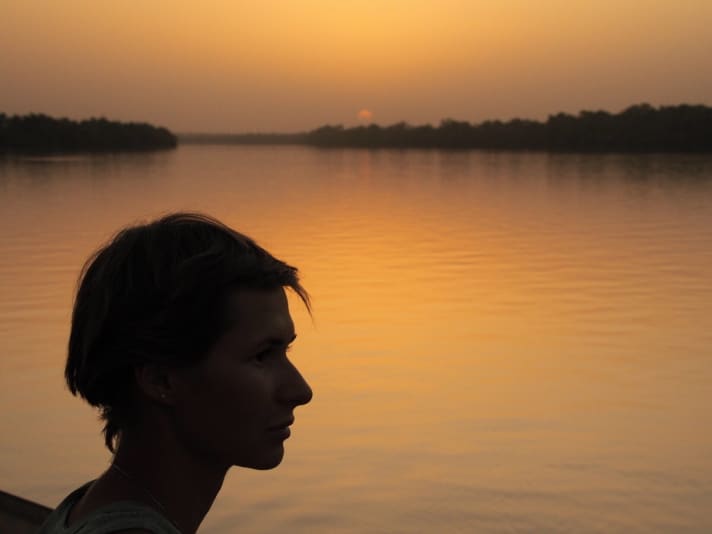
Since we have been travelling in The Gambia, we have been asked again and again for support and have seen many well-intentioned projects that are unfortunately not maintained and fall into disrepair over time. The director of the school in Bobmale is a clever and far-sighted man who made a good and sensible impression on us. He shows us pictures of the school from recent years: A lot has happened here. His aim is to make the school a place that the children enjoy attending, and we are convinced that the money will be well invested here in the long term. Anyone interested in supporting the construction of the well and the children of Bombale is welcome to do so via our Coffee Fund with the subject "Bombale".
In addition to supporting the construction of the well, we are also donating a football to the school. There is a football pitch, but no ball. The ball is presented to the pupils with great fanfare and the sports teacher immediately starts training with great enthusiasm. Now he and the pupils can finally take part in the district school championships for the first time.
Back to the sea
From Bombale, we head into Jurong Creek, which we are already familiar with. This time, however, we motor much further into the creek and find a quiet anchorage a few miles inside the side arm. We put the hammock in the dinghy and stretch it out between the mangroves, where it is pleasantly "cool" in the shade, i.e. below 40 degrees.
From Juron Creek, we continue downstream via Tendeba towards Banjul. We anchor on the bank for the night and witness a crocodile snatching a pelican. Loud screams and splashing startle us out of our sleep, and with the searchlight we are able to observe the scene, which takes place about 30 metres from the "Aracanga".
The next day we have to leave early. We start the engine at seven o'clock. During the routine check of the cooling water, we realise that the engine is not being cooled and start troubleshooting. The filter is clean, the impeller looks great. So we blow through all the hoses once, reassemble everything and try again. No cooling water again.
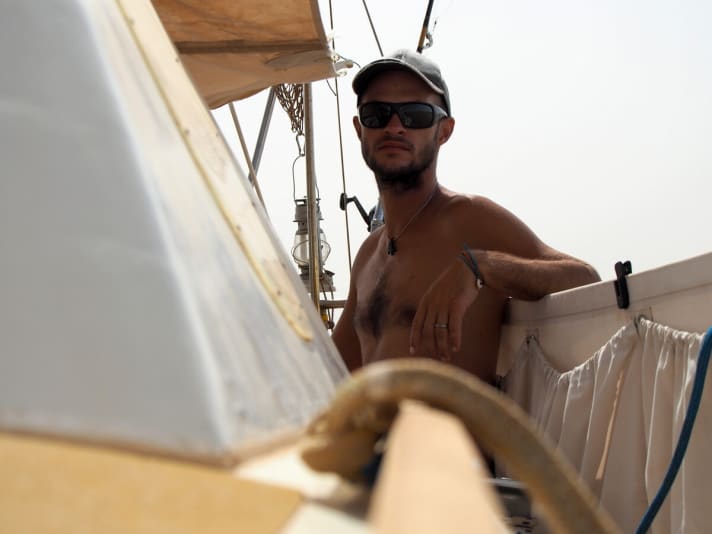
Somewhat perplexed, we remove the cooling water pump again - unfortunately, we have to remove the whole pump to change the impeller, as it sits quite tightly between the engine and gearbox -, inspect everything again and realise that the grub screw holding the impeller is sheared off. We install a new impeller straight away and two hours later than planned we are back on the road with our destination James Island, the last stop before Banjul. There we get our first taste of the Atlantic, which we haven't seen for almost two months. It smells of the sea, and a slight swell makes our "Aracanga" rock gently. How beautiful!
Further information, pictures and articles about the voyage of the "Aracanga" at Ahoy.blog.

